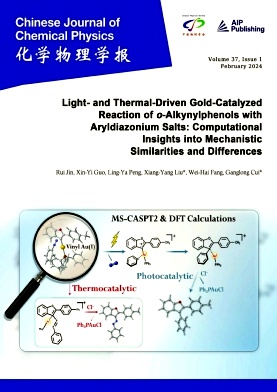
化学物理学报(英文版)(Chinese Journal of Chemical Physics) 知网万方维普
- CSCD
- 科核
- 主管单位:
中国科学技术协会
- 主办单位:
中国物理学会
- 国际刊号:
1674-0068;EISSN2327-2244
- 国内刊号:
34-1295/O6
- 学科分类:
- 字数:
10000-140000
- 有无基金:
/有基金 100.0%
- 周期:
CN外文-双月刊
- 特殊属性:
第一批认定学术期刊
- 电话:
0551-63601122(202401期)
- 邮箱:
cjcp@ustc.edu.cn(202401期)
- 复合因子:
0.452
- 综合因子:
0.262
- 收录:
知网,万方,维普
- 级别:
CSCD,科核
期刊简介
《化学物理学报》期刊已被查看: 次
更新频次
高频栏目:
ARTICLE-83.3%-期平均发文量13篇
中频栏目:
LETTER-33.3%-期平均发文量1篇
低频栏目:
专题:中国化学会第十七届全国化学动力学会议-16.7%-期平均发文量7篇
2023年03期其他-16.7%-期平均发文量8篇
2023年02期其他-16.7%-期平均发文量1篇
2023年01期其他-16.7%-期平均发文量1篇
2022年06期其他-16.7%-期平均发文量1篇
2022年05期其他-16.7%-期平均发文量1篇
2022年04期其他-16.7%-期平均发文量1篇
单位占比
C9高校-41.8%普本-21.8%
211高校-12.7%
985高校-10.9%
双一流-7.3%
研究院所-5.5%
一作占比
/有基金-100.0%投稿指南
1、投稿方式:在线投稿。
2、刊内网址:http://cjcp.ustc.edu.cn
(202401期)
3、投稿系统:
https://mc03.manuscriptcentral.com/cnjcp
4、刊内邮箱:cjcp@ustc.edu.cn
5、刊内电话:0551-63601122
6、出刊日期:双月刊,逢双月27日出版。
2024年5月8日星期三
投稿须知【官网信息】
Focus & Coverage
CJCP aims to bridge atomic and molecular level research in broad scope for disciplines in chemistry, physics, material sciences and life sciences including the follows:
Theoretical Methods, Algorithms, Statistical and Quantum chemistry, Computational Physical Chemistry & Chemical Physice;
Gas Phase Dynamics and Structure: Spectroscopy, Molecular Interactions, Scattering, and Photochemistry;
Condensed Phase Dynamics, Structure, and Thermodynamics: Spectroscopy, Reactions, and Relaxation Processes;
Surfaces, Interfaces, Single Molecules, Materials and Nanosciences;
Polymers, Biopolymers, and Complex Systems;
Other related topics.
Manuscript of Types
CJCP currently publishes following types of papers: Letters, Articles, Review, Comments and Errata.
Letters are brief and quick publications of short articles that report novel experimental results and original ideas or proposals for theories and experiments. Letters usually do not exceed 2000 words with less than 3 figures or tables, with an abstract not more than 150 words and less than 15 references. A more complete and detailed version can be submitted to CJCP or other peer-reviewed journal at a later time. Each issue of CJCP usually has 3 papers or less published as letters. Detailed materials, specifics of experimental conditions and brief derivations can be published as supplementary material along with the paper in an electronic version in the web edition.
Articles are thorough, complete, clear and concise reports on novel experimental and theoretical results with significance. Articles can be of normal length or extended length. A normal length article is usually less than 5000 words and 6 figures or tables, with an abstract less than 250 words, and usually with not less than 30 and not more than 60 references. An extended length article is usually less than 8000 words and 8 figures or tables, with an abstract less than 350 words, and usually with more than 50 references. Each article is required to give clear, concise, complete and objective description of the research background including brief development and current status of the related field of research, the problems intended to be solved, and the significance of the reported results. Detailed materials, specifics of experimental conditions and brief derivations can be published as supplementary material along with the paper in an electronic version in the web edition.
Reviews are generally on progress in rapidly developing fields. Reviews are generally invited by the editor. Submission without invitation is welcome with the consent of the editor, which can be granted on the basis of a pre-submission with a table of contents and a summary, as well as a list of major references. A review article is usually less than 9500 words and 12 figures or tables, with an abstract less than 450 words. A review is required to present clear, complete, and objective review and depiction of the historical background, problems and current status, recent progress and future perspectives in a research field. A review is not expected to be a reference report. Personal accounts with unique and critical assessments and perspectives are generally encouraged.
Comments and Errata are on experimental and theoretical results with significant or general interest published within the previous 12 months in CJCP, or published within the previous 6 months in other peer-reviewed journals. A comment is generally less than 1000 words and 2 figures or tables. Comments can only be published with critical peer-review, and only a limited number of comments with significance can be published. Errata can be made by the authors of papers published in CJCP within the previous 12 months. The content of the erratum is brief and short, limited to the experimental conditions and facts. Any reinterpretation of the results can be considered in the form of comments or regular papers. Comments and Errata on papers exceeding the above time limit can be considered with the consent of the editor on topics with ultimate significance. Editor-requested retractions, comments and errata on papers with major flaws, academic misconduct and falsification shall be sent to the authors?employers and the funding agency that supported the work.
Preparation
CJCP publishes in English with Chinese abstract. Authors are responsible for using of proper English spellings and grammars, with following requirements.
Title. Clear and concise. Usually less than 15 words. Without special symbols. Avoid big and general titles.
Author list. Number of authors is usually less than 4. Number of authors for collaborative work is usually less than 6. Roles of each author are encouraged to be clarified in the footnotes in the first page or in the acknowledgement section. Names, fax numbers and email addresses of the corresponding authors are listed in the footnotes in the first page.
Abstract. Concise, clear and abide by the number of words for each type of paper. Generally without special symbols.
Text. Except for letters, comments and errata, a manuscript usually has the following clearly labeled sections: introduction, theoretical background, methodology or experiments, results and discussion. Introduction and theoretical background can be put in one section. Review papers can have more freedom on arrangement of main text. The introduction section has to clearly present research purposes and motivations, and the relationship to the current development of the field. Any usage of more than two complete sentences or 30 words in the same logical sequence from the literature has to be clearly labeled and referenced. Self usage of previously published literature is usually limited to 10 sentences except for the introduction, methodology and experiment sections, in which self-usage of sentences or words in logical sequence is not allowed to exceed 1/3.
Acnowledgment.Acknowledgement of research funding sources, and other acknowledgment follows the main text section. They are generally on help received, and specification of roles for each author is encouraged.
Reference list. There is no excuse for the authors to neglect or omit directly related references by the authors or by others. Authors are responsible for the accuracy of the references. Unpublished results or materials are generally not encouraged to be listed. Group reference is not encouraged. Styles of major types of references should be as follows.
Periodical or journal: [1] Y. L. Yeh, C. Zhang, H. Held, A. M. Mebel, X. Wei, S. H. Lin, and Y. R. Shen, J. Chem. Phys. 114, 1837 (2001).
Book: [2] R. E. Hummel, Electronic Properties of Materials, 3rd Edn., New York: Springer-Verlag, 32, (2000).
Dissertation: [3] S. Zhang, Ph.D. Dissertation, Hefei: University of Science and Technology of China, (2006).
上一篇:中华医学教育探索杂志(原:医学教育探索)下一篇:数学杂志
《化学物理学报》同类化学期刊
-
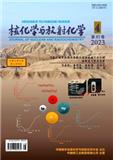
核化学与放射化学
北核,CSCD,科核,高T2
CN中文-双月刊影响因子0.618
-
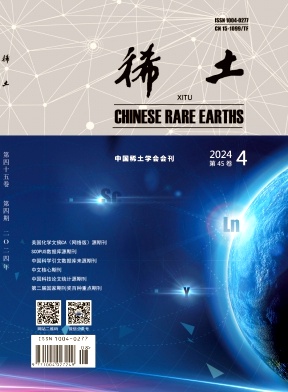
稀土
北核,科核,CSCD扩,武A-,高T2
CN中文-双月刊影响因子1.041
-
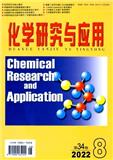
化学研究与应用
北核,科核,武B+
CN中文-月刊影响因子0.911
-
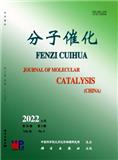
分子催化(中英文)
北核,科核,CSCD扩,武A
CN中文-双月刊影响因子1.802
-
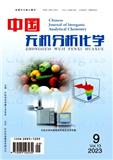
中国无机分析化学(原:中国无机分析化学文摘)
北核,高T3,CACJ-权威,武B+
CN中文-月刊影响因子1.591
-
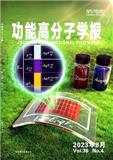
功能高分子学报
北核,CSCD,科核,高T2,武B+
CN中文-双月刊影响因子1.206
-

质谱学报
北核,CSCD,科核,高T2,EI(中国2024),武B+
CN中文-双月刊影响因子1.348
-
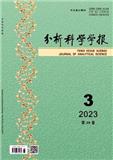
分析科学学报
北核,科核,CSCD扩,武B+
CN中文-双月刊影响因子1.227
常见问题
-
化学物理学报杂志社官网、联系方式是什么?
化学物理学报杂志社官网:http://cjcp.ustc.edu.cn
投稿网址:https://mc03.manuscriptcentral.com/cnjcp联系电话:0551-63601122(202401期)
投稿邮箱:cjcp@ustc.edu.cn(202401期) -
化学物理学报杂志是核心期刊么?
化学物理学报是核心期刊,级别是:CSCD,科核, 是:化学分类下的知网,万方,维普收录的期刊。
-
请问你们是化学物理学报杂志社吗?
我们不是《化学物理学报》杂志社。本站主要从事期刊信息展示与期刊推荐,不是任何杂志官网,直投稿件请联系杂志社。本站仅提供免费的学术指导、论文辅导、期刊投稿信息整理收集服务。
-
你们指导服务后可以保证文章被发表吗?
期刊发表的成功与否,主要取决于文章内容的质量。编辑老师会根据研究领域、创新性等多因素进行考量。我们会帮助您理解期刊的发表要求,助力提升发表几率,从而增加发表的机会。
-
晋级论文能否在报纸上发表?
在学术界,论文的发表往往被视为研究者职业发展的重要一环。晋级论文,即为了获得更高职称或学术地位而撰写的学术论文,通常需在专业期刊上发表。然而,许多人可能会问
